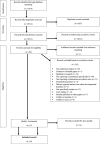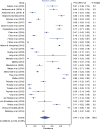Prevalence of Victimisation in Autistic Individuals: A Systematic Review and Meta-Analysis
- PMID: 35524162
- PMCID: PMC10486169
- DOI: 10.1177/15248380221093689
Prevalence of Victimisation in Autistic Individuals: A Systematic Review and Meta-Analysis
Abstract
Autistic individuals are at an increased risk of experiencing victimisation. Previous reviews have focussed specific types of victimisation. Thus, a clearer picture considering the range of victimisation experiences autistic people face is required. This systematic review aims to identify the prevalence of victimisation in autistic individuals considering a variety of victimisation types (e.g., bulling, sexual victimisation, and crime) in both adults and children from clinical and community settings. Through systematic searches of relevant databases, 291 studies met the criteria for review. Of those, 34 studies met the inclusion criteria: a) quantitative studies, b) involving autistic individuals, c) reporting prevalence rates of victimisation. Meta-analysis found a pooled prevalence rate of victimisation of 44% in autistic individuals. Subgroup analysis examined moderating factors as high heterogeneity was present. This found the pooled prevalence rates for bullying to be 47%, 16% for child abuse, 40% for sexual victimisation, 13% for cyberbullying, and 84% for multiple forms of victimisation in autistic individuals, though heterogeneity remained. Correction for participants' age, reporter used, and the population which the sample was recruited from did not reduce heterogeneity. Although heterogeneity impedes the definitive interpretation of the findings, this review illustrates the need for strategies and interventions to reduce the incidence of victimisation.
Keywords: ASD; Autism; Victimisation; bullying; child abuse; crime; meta-analysis; systematic review.
Conflict of interest statement
The author(s) declared no potential conflicts of interest with respect to the research, authorship and/or publication of this article.
Figures
Similar articles
-
Music therapy for autistic people.Cochrane Database Syst Rev. 2022 May 9;5(5):CD004381. doi: 10.1002/14651858.CD004381.pub4. Cochrane Database Syst Rev. 2022. PMID: 35532041 Free PMC article.
-
Signs and symptoms to determine if a patient presenting in primary care or hospital outpatient settings has COVID-19.Cochrane Database Syst Rev. 2022 May 20;5(5):CD013665. doi: 10.1002/14651858.CD013665.pub3. Cochrane Database Syst Rev. 2022. PMID: 35593186 Free PMC article.
-
Tobacco cessation interventions for young people.Cochrane Database Syst Rev. 2006 Oct 18;(4):CD003289. doi: 10.1002/14651858.CD003289.pub4. Cochrane Database Syst Rev. 2006. Update in: Cochrane Database Syst Rev. 2013 Aug 23;(8):CD003289. doi: 10.1002/14651858.CD003289.pub5. PMID: 17054164 Updated.
-
Psychological and/or educational interventions for the prevention of depression in children and adolescents.Cochrane Database Syst Rev. 2004;(1):CD003380. doi: 10.1002/14651858.CD003380.pub2. Cochrane Database Syst Rev. 2004. Update in: Cochrane Database Syst Rev. 2011 Dec 07;(12):CD003380. doi: 10.1002/14651858.CD003380.pub3. PMID: 14974014 Updated.
-
Home treatment for mental health problems: a systematic review.Health Technol Assess. 2001;5(15):1-139. doi: 10.3310/hta5150. Health Technol Assess. 2001. PMID: 11532236
Cited by
-
Examining subjective understandings of autistic burnout using Q methodology: A study protocol.PLoS One. 2023 May 19;18(5):e0285578. doi: 10.1371/journal.pone.0285578. eCollection 2023. PLoS One. 2023. PMID: 37205659 Free PMC article.
-
Mapping the differential impact of spontaneous and conversational laughter on brain and mind: an fMRI study in autism.Cereb Cortex. 2024 May 2;34(5):bhae199. doi: 10.1093/cercor/bhae199. Cereb Cortex. 2024. PMID: 38752979 Free PMC article.
-
The Impact of Intersectional Disadvantage on Autistic Women's Experiences of Interpersonal Violence: A Narrative Review.Autism Adulthood. 2025 May 28;7(3):249-260. doi: 10.1089/aut.2023.0100. eCollection 2025 Jun. Autism Adulthood. 2025. PMID: 40539211
-
Compassion-focused therapy with autistic adults.Front Psychol. 2023 Oct 26;14:1267968. doi: 10.3389/fpsyg.2023.1267968. eCollection 2023. Front Psychol. 2023. PMID: 37965655 Free PMC article.
-
A mixed method examination: how stigma experienced by autistic adults relates to metrics of social identity and social functioning.Front Psychiatry. 2023 Oct 26;14:1243618. doi: 10.3389/fpsyt.2023.1243618. eCollection 2023. Front Psychiatry. 2023. PMID: 37965369 Free PMC article.
References
-
- Ashburner J., Saggers B., Campbell M. A., Dillon‐Wallace J. A., Hwang Y. S., Carrington S., Bobir N. (2019). How are students on the autism spectrum affected by bullying? Perspectives of students and parents. Journal of Research in Special Educational Needs, 19(1), 27–44. 10.1111/1471-3802.12421 - DOI
-
- Autism Act (2009). Chapter 15. https://services.parliament.uk/bills/2008-09/autism.html.
Publication types
MeSH terms
LinkOut - more resources
Full Text Sources
Medical
Miscellaneous





